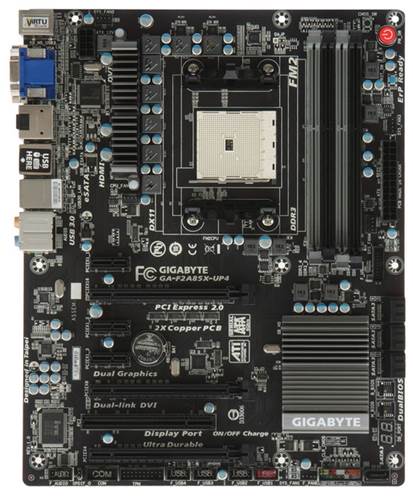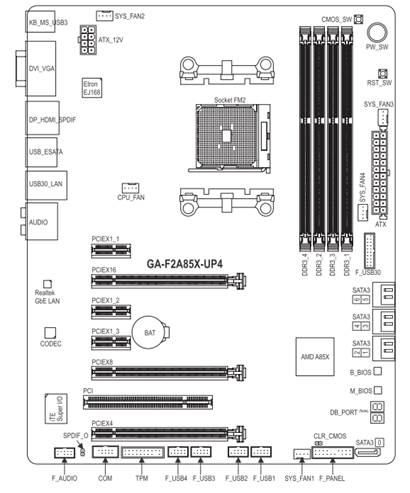The Socket FM2 processor can work with the
current AMD A75 central controller or the A55 Fusion, which has been used in
Socket FM1 mainboard. That is why very few new mainboard for this type of
chipset were launched up to now. The junior modules just support USB 2.0 and
SATA 3 Gbps ports, while senior modules support all current standards,
including USb 3.0 and six SATA 6 Gbps ports. AMD also prepared A85X chipset for
their introduction of Socket FM2 processor, which supports CrossFireX, up to 8
SATA 6 Gbps ports and RAID storage subsystem configuration. Of course, we can
claim that these are not significant improvements, but what else could we
expect? Integrated wireless interfaces? Even AMD A75 functions are not modern
enough to create a mainboard with the most updated characteristics. This
scenario is very different from what is happening in Intel, where the chipsets
are upgraded slowly, and cannot really satisfy the users’ demand and
expectations. That is why its features need to be expanded with the additional
monitor and chips. However, although the last AMD chipset generation is still
very popular, we still keep concentrating on the mainboard based on the new AMD
A85X and will start with our today’s hero - Gigabyte GA-F2A85X-UP4.

The
inside design
Again, we want to draw the attention to the
fact that Gigabyte has the strategy to name their products very simple and easy
to monitor. F2 replaces Socket FM2, A85X is the name of the chipset. We also
know that UP shows that this mainboard is designed by using Ultra Durable 5
technology. The current Ultra Durable 5 version includes all characteristics of
the current Gigabyte mainboard: the 2 oz copper PCB, high quality inside
components, protection against overheating and voltage fluctuation, anti-static
and anti-humidity technologies. The main distinguishing characteristic, the
factor that leads to the decision of giving this technology a new number, is
the use of modern component base. The voltage regulator circuitry of the Ultra
Durable 5 mainboard uses IR3550 PowIRstage with enhanced feature from
International Rectifier. They became more efficient, consuming less power, less
heat and are able to work well under heavily load. Finally, the last number on
the product’s name, 4, represents the module number: the larger the number the
higher the position. All of these things together give us a very easy to read
name - Gigabyte GA-F2A85X-UP4.
The board is compatible with all of the
contemporary Socket FM2 processors. Four DDR3 DIMM slots allow using 64 GB RAM,
when the corresponding memory modules are popular in the market. They support
not only AMD Memory Profile configurations (AMP) but also Extreme Memory
Profile (XMP), the configuration which was introduced by Intel. The board is
featured by 3 PCI Express 2.0x16 slots, because AMD has not implemented the
third version for their products’ interfaces. A specific graphics accelerator
works at the speed of x16. With two cards, the slots will share the bandwidth
(2x8), and the third slot just allows device connections which have the least
speed of x4. On its top, there are 3 PCI Express 2.0 x1 slots and 1 PCI slot
for the expansion cards. Out of the eight ports provided by AMD A85X chipsets,
we have seven, and another one is located in the back as an eSATA port.

Images
of the ports
General speaking, we can find the ports and
connectors in the back:
·
Universal PS/2 connectors for keyboards and mouse
·
Two USB 3.0 ports (blue connectors) are produced
by Etron EJ168 controller, and two additional USB 3.0 and a charging port
inside
·
D-Sub, DVI-D, HDMI Display Port video
·
Two USB 2.0 ports, with eight available for
charging connections
·
Six eSATA 6 Gbps ports using all functions of
the chipsets, same as 7 SATA 6 Gbps ports
·
One local network port (network adapter is built
based on Realtek RTL8111E Gigabit)
·
network controller device
·
Optical S/PDIF and six similar audio-jacks
provided by the eight-channel Realtek ALC 892 code.
As you can see,
the extensive function of AMD A85X gives the Gigabyte design a special feature
without the need of any other controller devices or chipsets from the third
producer. However, this is the top products in the Socket FM2 series of
Gigabyte. The reason that makes them outstanding is the additional features,
for example the Power On button, Reset button and Clear CMOS and POST-code
indicator. Moreover, we cannot ignore the fact that they are equipped with two
BIOS chips which help increasing the reliability, and although the users can
only approach one of them, those reserve chips are always available in case
that the content of the primary needs to be recovered. The graphics card slots
have very wide handy latches on them and five onboard fan connectors.

Map
of the inside architecture